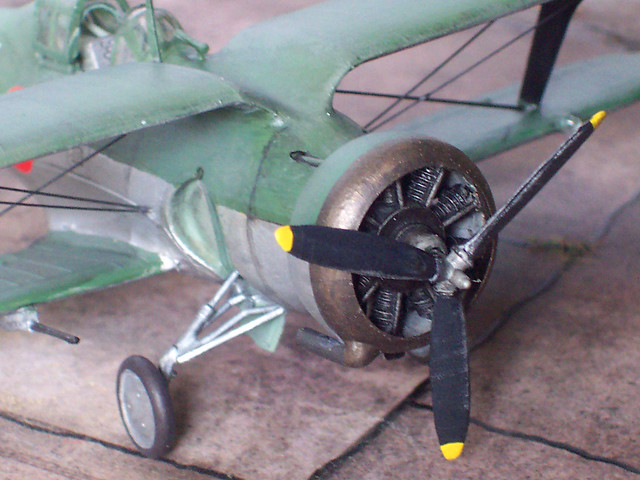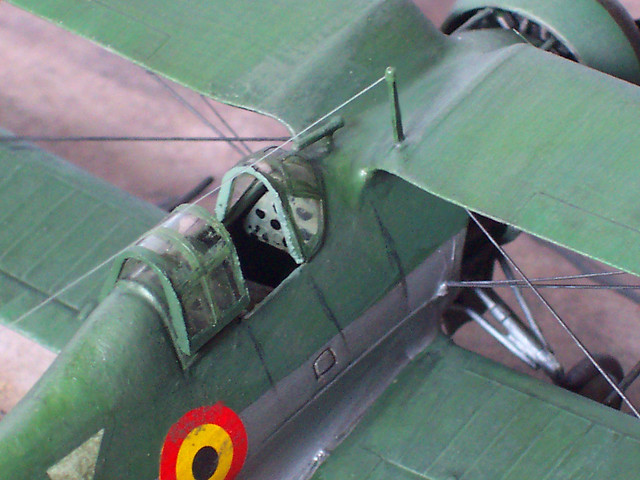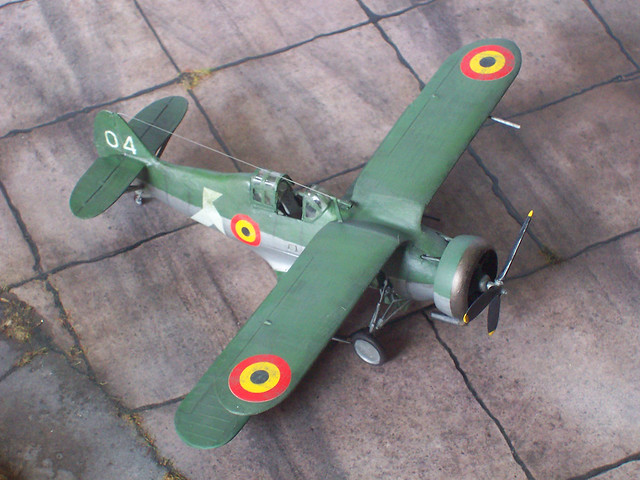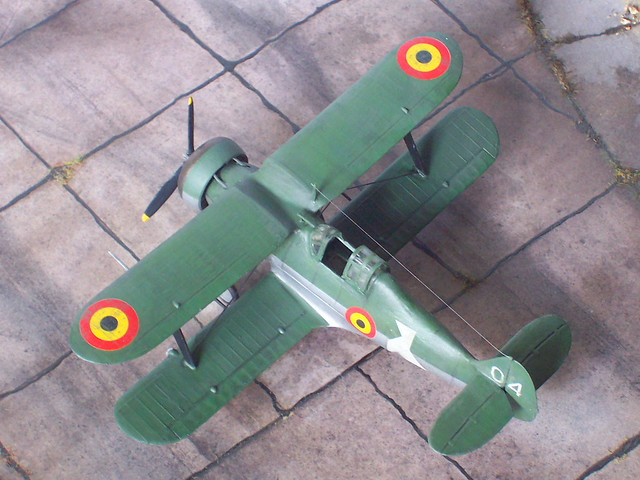Mal wieder was Kleines, und eine Art internationale Co-Produktion. Los ging es mit folgendem Pixel-Profil auf whatifmodelers.com, ähnlich der PZL 24, aber ein Doppeldecker fiktiver britischer Herkunft:

Mir kam die Idee, ob da nicht ein einziehbares Fahrwerk ergänzt werden könnte? Und nachdem ich beim Urheber rausbekommen hatte, dass die Profile vage auf der Polikarpov I-15 basieren, beschloss ich einfach meine Idee in Hardware umzusetzen. Und schließlich ist daraus ein Kitbash entstanden - zwar etwas anders, als das "Vorbild", aber immer noch als Verwandtschaft erkennbar:

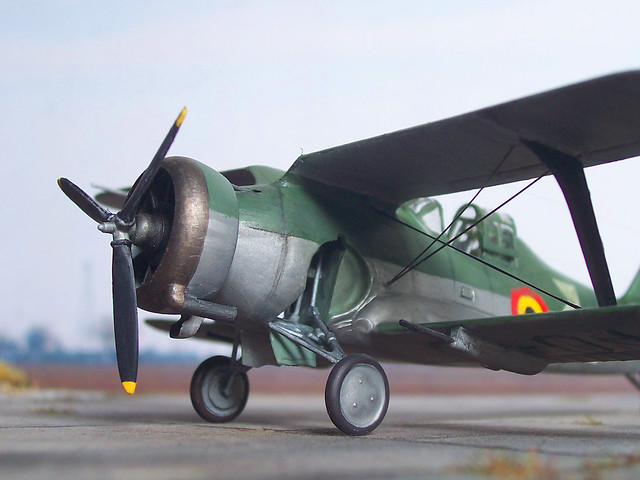
 Some background:In the late 1920s, the Aéronautique Militaire (Belgian Air Force) set out to replace its old aircraft. Accordingly, Belgian officers attended the Hendon Air Display where they saw a Fairey Firefly and met Fairey staff. The Firefly toured Belgian air bases in 1930 and met with approval from pilots. This led to a contract for 12 UK-built Firefly II to be followed by a further 33 aircraft built in Belgium.
Some background:In the late 1920s, the Aéronautique Militaire (Belgian Air Force) set out to replace its old aircraft. Accordingly, Belgian officers attended the Hendon Air Display where they saw a Fairey Firefly and met Fairey staff. The Firefly toured Belgian air bases in 1930 and met with approval from pilots. This led to a contract for 12 UK-built Firefly II to be followed by a further 33 aircraft built in Belgium.
Fairey already had a number of Belgians in key roles in the company; Ernest Oscar Tips and Marcel Lobelle had joined during the First World War. Tips went to Belgium to set up the subsidiary company. He based the new company near Charleroi. The fighter ace Fernand Jacquet who operated a flying school nearby joined the company in 1931.
Avions Fairey received further orders for Fireflies followed by Fairey Foxes which would be the main aircraft of the Belgian Air Force; being used as a fighter, bomber and training aircraft.
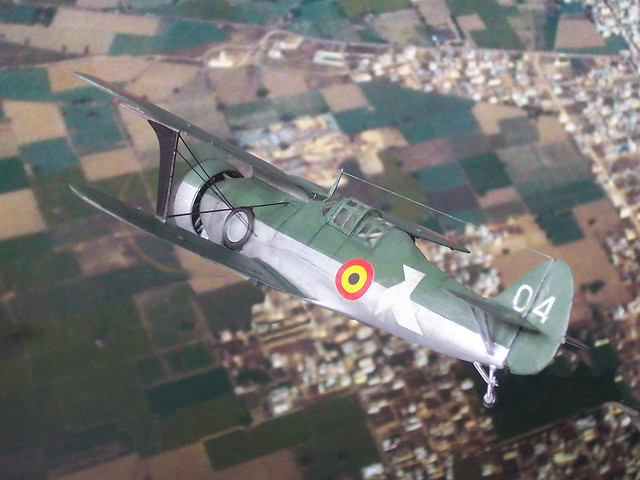
Most of Avions Fairey work was on military contracts. The contact with the Belgian military led to Fairey developing the Fairey Fantôme as a followup to the Firefly for the Belgians. Of the three prototypes, two ended up in Spain (via the USSR) the third as a test aircraft with the RAF.
Another indigenous design of Avions Fairey was the Faune fighter, or better: it's fall-back design. The original design for the Faune started as an advanced (for the era) monoplane under the direction of Ernest Oscar Tips in 1934. He grew concerned that the design would not mature, and ordered a backup biplane design, just to be safe.

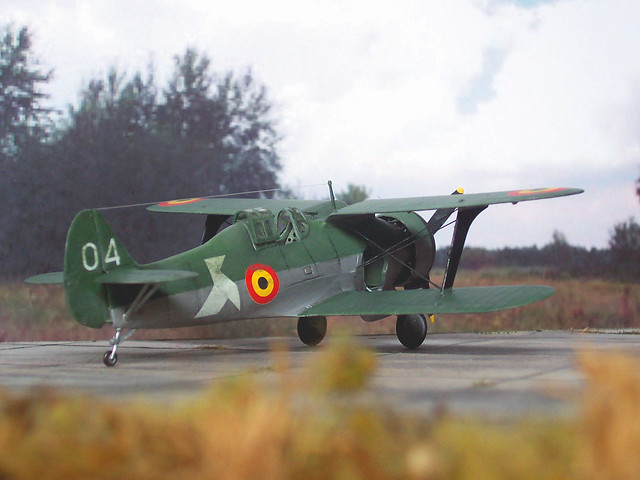
Internally called the "Faune-B", the alternative biplane was also a modern design with staggered, gulled upper wings that were directly attached to the fuselage and stabilized by single spars. The single bay wings were of wooden construction, while the fuselage was of mixed steel and duralumin construction, with a fabric covered steering surfaces.
Aerodynamic problems with the favored monoplane design led in 1935 to an end of its development, and further resources were allocated to the biplane. The most significant change of this revised version was the introduction of a retractable landing gear, which necessitated the lower wing main spar to be moved backwards by almost 1' and led to a distinctive wing layout.
In this modified guise the first flight was made in October 1936 with Fernand Jacquet at the controls, powered by an imported Bristol Jupiter engine and outfitted with a wooden, fixed pitch propeller. Armament comprised four 7.5 mm (.295 in) MAC 1934 machine guns with 300 RPG, two synchronized in the upper forward fuselage, and one under each lower wing, mounted in an external nacelle outside the propeller disc.
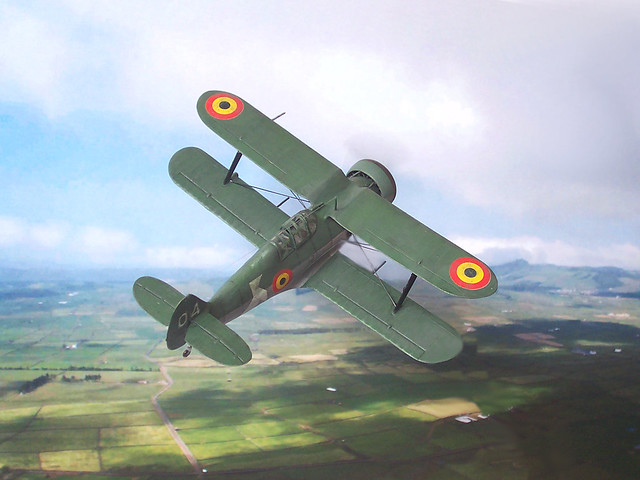
The Belgian Air Force accepted the fighter and production as Mk. I started in 1938, now powered by a licensed built Bristol Mercury that drove a three blade variable pitch propeller, and a fully enclosed cockpit. Compared with the very similar Gloster Gladiator, which was used by the Aviation Militaire Belge at that time, too, the Faune showed a higher speed and better climb rate, but was not as agile. The field of view for the pilot was poor, especially on the ground, and the narrow and low landing gear made ground handling, esp. on unprepared airfields, hazardous. Furthermore, the landing gear's complicated manual mechanism was prone to failure, and as a consequence the landing gear was frequently kept down so that the aerodynamic bonus was negated.
In late 1939 a total of 42 Avions Fairey Faunes had been built, and in order to compensate for the weaknesses trials were made to incorporate heavier armament in early 1939: the wing-mounted machine guns were on some machines replaced by 20mm Hispano-Suiza HS.404 cannon in deeper fairings and with 40 RPG, and the modified machines were designated Mk. IA. Around 20 machines were converted from service airframes and reached the active squadrons in early 1940. Furthermore, one Faune Mk. I was experimentally outfitted with a streamlined cowling, designated Mk. II, but befor the machine could be tested or even flown, Belgium had been occupied.

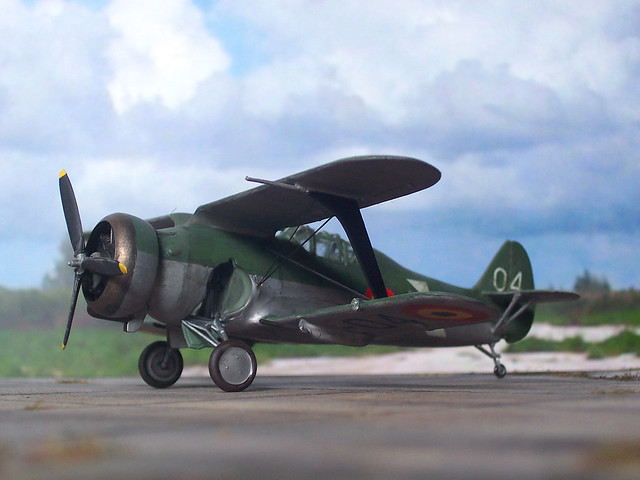
With the looming German neighbors, Belgium also ordered Hawker Hurricanes to be built in Belgium. However, on 10 May 1940, the Avions Fairey factory was heavily bombed by the Germans, the company personnel evacuated to France, and then left for England. Their ship was sunk by German bombers outside St Nazaire, though, and eight Fairey staff were killed; the survivors worked for the parent company during the Second World War. None of the Belgian Faunes survived this WWII episode.
General characteristics: Crew: 1
Length: 27 ft 5 in (8.36 m)
Wingspan: 32 ft 3 in (9.83 m)
Height: 11 ft 9 in (3.58 m)
Wing area: 323 ft2 (30.0 m2)
Empty weight: 3,217 lb (1,462 kg)
Loaded weight: 4,594 lb (2,088 kg)
Powerplant: 1× Bristol Mercury VIII radial engine, 625 kW (840 hp)
Performance: Maximum speed: 253 mph (220 knots, 407 km/h) at 14,500 ft (4,400 m)
Cruise speed: 210 mph[94]
Stall speed: 53 mph (46 knots, 85 km/h)
Endurance: 2 hours
Service ceiling: 32,800 ft (10,000 m)
Rate of climb: 2,300 ft/min[94] (11.7 m/s)
Climb to 10,000 ft (3,050 m): 4.75 min
Armament: Initially (Mk. I) two synchronised .303" Vickers machine guns in fuselage sides,
plus two .303" Lewis machine guns; one beneath each lower wing.
Mk. IA aircraft had the wing-mounted machine guns replaced by
two 20mm Hispano-Suiza HS.404 cannon
The kit and its assembly:Wie gesagt, Kitbashing war angesagt. Für das Fahrwerk schwebte mir einen Lösung ähnlich der Grumman F4F vor, und fand schließlich in der pummeligen Curtiss SBC ein geeignetes Spender-Design.
Tatächlich ist die Faune eine Kreation aus einer ICM I-15 (wunderbarer Bausatz, da ist sogar die interne Rumpfstruktur als Einzelteile bei!), einer Heller SBC und dem Bug und Triebwerk einer Vickers Wellesley von Matchbox. Und natürlich einer Menge Spachtel.


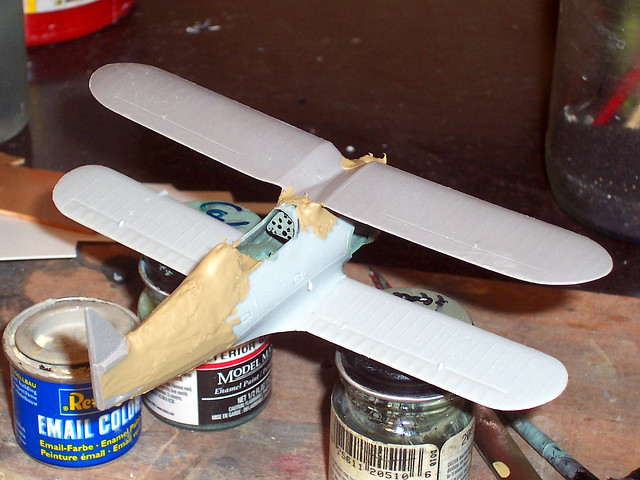
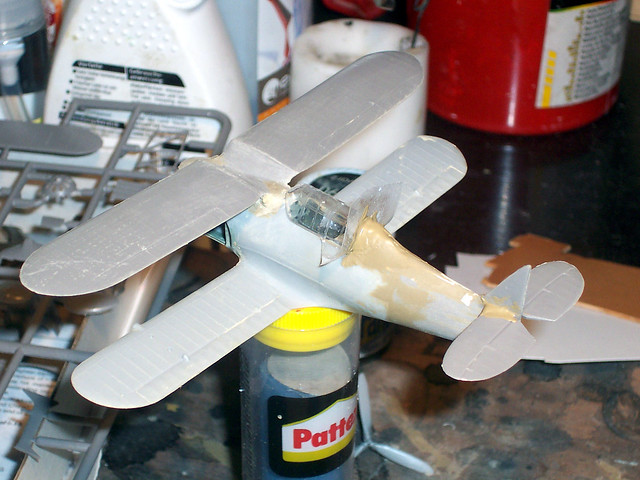
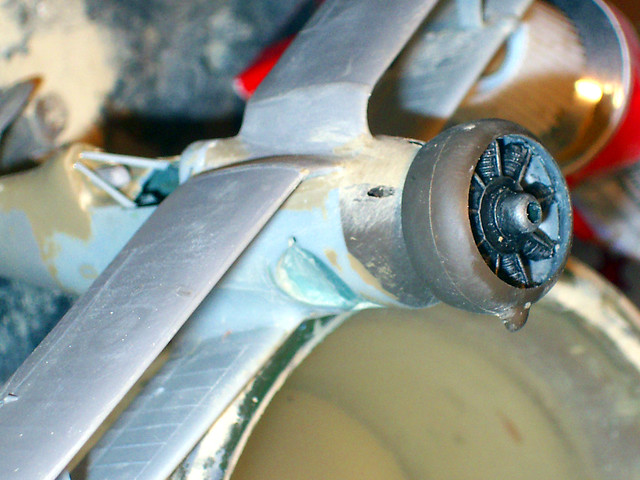
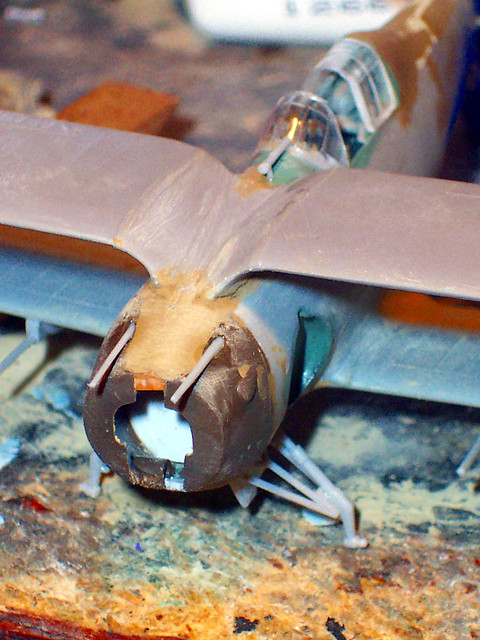
For die Lackierung hatte ich mich schon vorab für die belgische Variante aus dem Profil entschieden, und daraus leitete sich denn auch der Hersteller ab (ja, es gab
wirklich einen belgische Dependance von Fairey).
der Anstrich ist zweifarbig und simpel, unten Aluminium (Basis: Revell Acryl), oben Khaki (Modelmaster Enamel French Khaki), dazu etwas Tuschewashing und Trockenbemalung. Die Innenflächen sind in RAF Cockpitgrün gehalten.
Die Aufkleber sind zusammengepuzzelt und zum Glück minimalistisch - so stammen die Staffelabzeichen von einer Jubiläums-Mirage 5 der belgischen Luftwaffe und die "J-04"-Codes unter den Tragflächen von einer chilenischen D.H. Vampire...
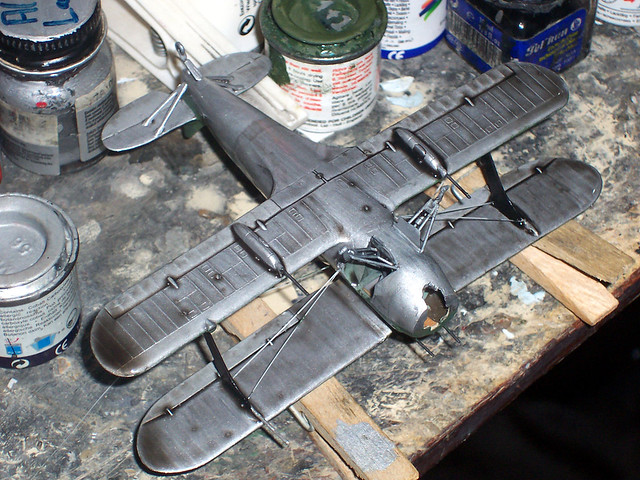
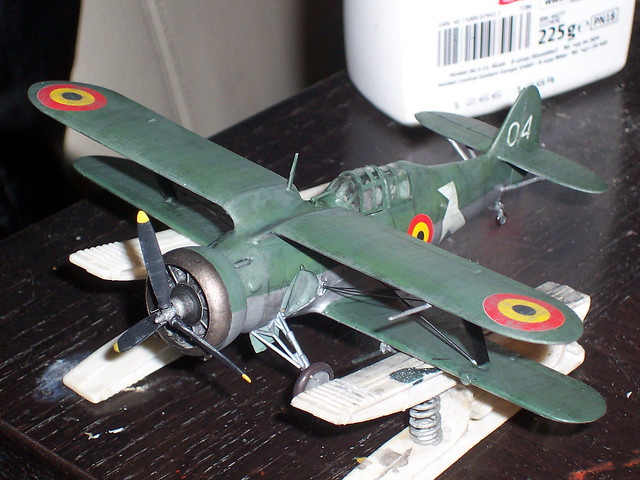
Sehr plausibel geworden, und man sieht dem Ding nicht an, wie sehr es zusammengestückelt wurde.!
